
Haridwar is a city and municipal corporation in the Haridwar district of Uttarakhand, India. With a population of 228,832 in 2011, it is the second-largest city in the state and the largest in the district.

Tulsidas was a Ramanandi Vaishnava Hindu saint and poet, renowned for his devotion to the deity Rama. He wrote several popular works in Sanskrit and Awadhi, but is best known as the author of the Hanuman Chalisa and of the epic Ramcharitmanas, a retelling of the Sanskrit Ramayana based on Rama's life in the vernacular Awadhi.

Bundelkhand is a geographical and cultural region and a proposed state and also a mountain range in central & North India. The hilly region is now divided between the states of Uttar Pradesh and Madhya Pradesh, with the larger portion lying in the latter state.

The Kashi Vishwanath Temple is a famous Hindu temple dedicated to Lord Shiva. It is located in Vishwanath Gali of Varanasi, Uttar Pradesh in India. The temple stands on the western bank of the holy river Ganga, and is one of the twelve Jyotirlingas, the holiest of Shiva temples. The main deity is known by the names Shri Vishwanath and Vishweshwara literally meaning Lord of the Universe. Varanasi was called Kashi ("shining") in ancient times, and hence the temple is popularly called Kashi Vishwanath Temple.

Al Wajh, also written Al Wejh, is a coastal city in north-western Saudi Arabia, situated on the coast of the Red Sea. The city is located in the Tabuk Province. It is one of the largest cities in Tabuk region, with a population of 50,000 as of 2013.

Nakki Lake is a lake situated in the Indian hill station of Mount Abu in Aravalli range.
Kahalgaon is a town and a municipality in Bhagalpur district in the state of Bihar, India. It is located close to the Vikramashila, that was once a famous centre of Buddhist learning across the world, along with Nalanda during the Pala dynasty. The Kahalgaon Super Thermal Power Plant (KhSTPP) is located near the town(3 km).

Benares or Banaras State was a kingdom and later princely state in what is today Uttar Pradesh, India. On 15 October 1948, Benares' last ruler signed the accession to the Indian Union.
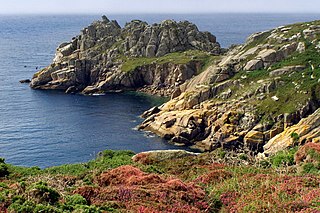
Treryn Dinas is a headland near Treen, on the Penwith peninsula between Penberth Cove and Porthcurno in Cornwall, England.
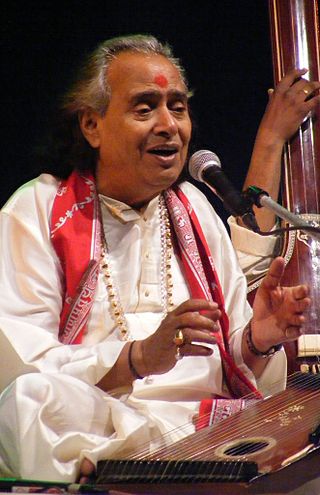
Pandit Chhannulal Mishra is a celebrated Hindustani classical singer from Banaras, a noted exponent of the Kirana gharana (school) of the Hindustani classical music and especially the Khayal and the 'Purab Ang' – Thumri.

Scindia Ghat is one of the ghats in Varanasi and borders Manikarnika, a place of Hindu cremation, to the north. At this ghat, a tilted Shiva temple can be found lying partially submerged in the Ganges River and it is argued that this ghat collapsed under its own excessive weight. The ghat is named after the Scindias, who built it in 1830. Above the ghat, several of Kashi’s most influential shrines are located within the tight maze of alleys of Siddha Kshetra. According to mythology, Agni, the Hindu God of Fire, was born here. Hindu devotees propitiate at this place to Vireshwara, the Lord of all heroes, for a son.
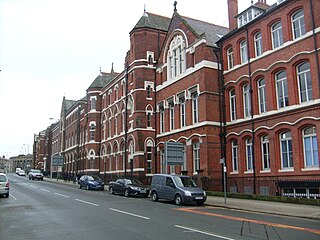
Mount Pleasant is a street in Liverpool city centre. It is towards one end of Hope Street, and is the location of the Liverpool Metropolitan Cathedral.
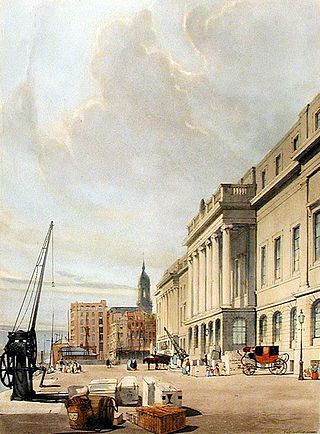
Thomas Shotter Boys (1803–1874) was an English watercolour painter and lithographer.

James Thomson (1788–1850) was a British engraver, known for his portraits. He completed his apprenticeship in engraving and then established himself independently, following the dot and stipple style. His engravings and paintings featured both leading figures of his day and those of previous periods.
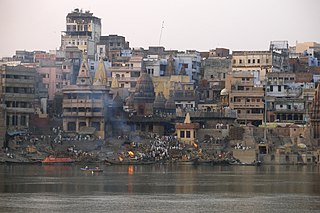
Varanasi is a city on the Ganges river in northern India that has a central place in the traditions of pilgrimage, death, and mourning in the Hindu world. The city has a syncretic tradition of Muslim artisanship that underpins its religious tourism. Located in the middle-Ganges valley in the southeastern part of the state of Uttar Pradesh, Varanasi lies on the left bank of the river. It is 692 kilometres (430 mi) to the southeast of India's capital New Delhi and 320 kilometres (200 mi) to the east of the state capital, Lucknow. It lies 121 kilometres (75 mi) downstream of Allahabad, where the confluence with the Yamuna river is another major Hindu pilgrimage site.
Thomas Alfred Woolnoth (1785–1857) was an English engraver. He was known for his portraits of theatre people. He also painted, and engraved works of Correggio and Van Dyck. Woolnoth was engraver to Queen Victoria. His work was also included in Cadell and Davies Britannia depicta.
Shiv Prasaad Singh was an Indian writer, university professor and scholar of the Hindi language. He is well-known for writing novels, short stories and critiques in Hindi. He was formerly a professor of Hindi literature in Benares Hindu University. He received the Kendra Sahitya Akademi Award in 1990 for his novel Neela Chand.
Kharsali is a small village near Yamunotri Temple in Uttarakhand, India, that hosts the idol of Goddess Yamuna during winters, after it is brought down in a ritual ceremony from the temple, some fifteen hundred feet higher, as it becomes inaccessible after being snowed in. The priests of the Yamunotri Temple hail from this village. The idol is brought down from the temple, a four-mile trek away, during the festival of Diwali with great celebration, and returns to the temple in spring.













